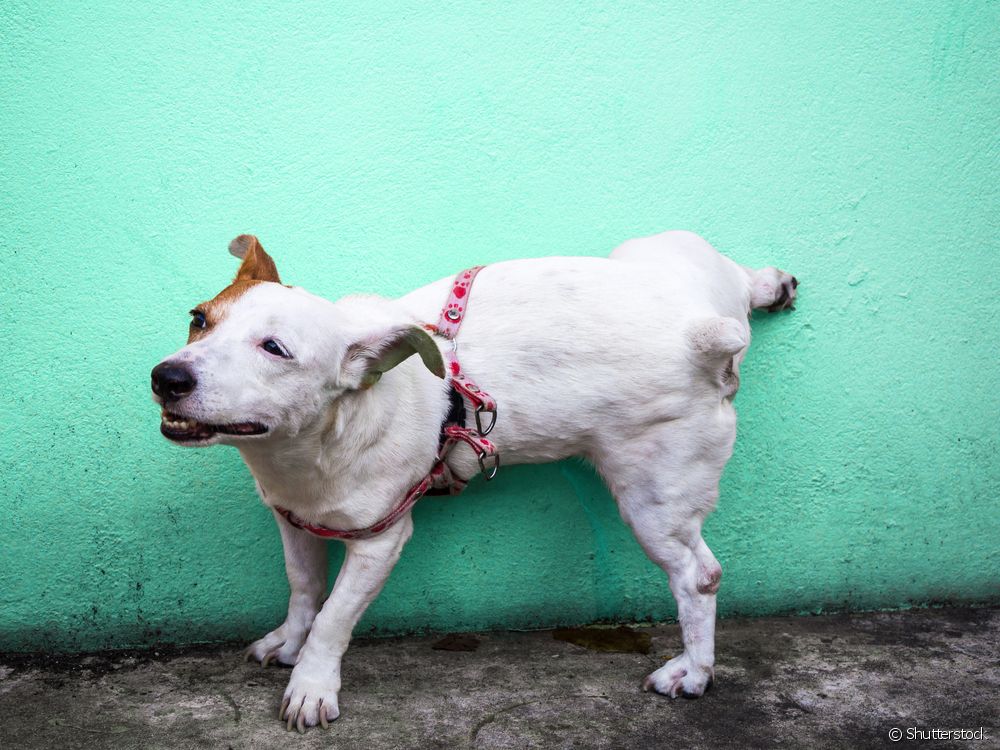What to do to stop your dog marking territory: 7 tips to deal with peeing outside!

Table of contents
Having a dog at home is all joy, but it is always good that the owner is prepared to deal with some inconvenient behaviors of the animal. One of them is peeing out of place to leave the smell in every corner of the house. What to do to stop the dog from marking territory? The custom is unpleasant and can even take the peace of mind of many guardians out there. To help you, we have separated some tipsto prevent the dog from marking territory at home and peeing where it shouldn't. Follow along!
Dog pee out of place: why do they mark territory?
The first step to correcting your furry friend's behavior is to understand the reason for marking territory for the dog. Dogs have a very keen sense of smell and can discover various things by the smell of urine, such as the order of social hierarchy and the presence of a female dog in heat. Therefore, peeing on places and objects is a way to mark the territory and prove that it is the dominant oneof that space.
It is essential to observe your pet's habits to identify possible changes in behaviour, such as when the dog starts to pee where it did not do so before. This attitude may mean that your four-legged companion is going through a stressful phase. Any change in the environment or in the dynamics of the house, such as the arrival of a new family member, can provokefeelings such as anxiety and insecurity.
How to teach the dog to pee in the right place? See 7 tips to solve the problem!
- Catch in the act: the dog will only understand that it is doing something wrong if it is corrected instantly. Therefore, the guardian must dedicate himself and supervise the pet for as long as possible, aiming to be present at the exact moment when the animal pees where it should not. Be firm and emphasize the word "no". With luck and a lot of commitment, a week or two of training will be enough to solve it.the problem;
- Indicate the right place: That's the basics, right? Every dog should have its own place to go, such as doggy toilet mats or even a newspaper. As soon as you find the pet peeing in the wrong place, direct it to its own "toilet";
- Use distractions to your advantage: a good idea is to distract the dog with noises and movements, such as swinging a bottle full of stones, for example, right at the H-hour. For this, the tutor needs to be aware of the signs that the dog manifests when it is about to make the mistake. Sniffing a lot somewhere or turning around several times can be some indications that the mistake is about to happen;
- Do not suspend the water: Many people make the mistake of thinking that they should limit their pet's access to water. This is a mistake! The more water your dog drinks, the better. This is because drinking water helps purify the urinary system and prevents the accumulation of bacteria and other agents;
- Positive feedback: Use praise and rewards when your dog finally urinates in the right place, and reward them with cuddles, treats and fun activities;
- Take more walks: this way, the pets will be able to explore new territories outside the house, reducing the chances of peeing indoors;
- Clean the site thoroughly: if the smell of pee remains in the area, it is very likely that the dog will feel the urge to mark the territory there again. Therefore, clean up the urine immediately and make sure not to leave any scent traces!

How to get the smell out of dog pee?
Removing all dog pee and cleaning the area thoroughly can prevent him from becoming obsessed with urinating in the same place. The first step is to dry the area with a pet-specific cloth that is not normally used for cleaning the house. Only when the area is completely dry, move on to the next phase: the use of disinfectant.
The product should never be placed on a surface that is still dirty with urine remains. In addition to nullifying the effect of the substance, the mixture of smells can also be very unpleasant. Always opt for a disinfectant without ammonia, the compound is present in the urine in the dog and can make the place even more attractive to the dog.
It is also very important to be careful with homemade solutions. Your pet may have an allergy or reaction from contact with unknown products. Therefore, products such as vinegar and bicarbonate should not be used without the recommendation of a veterinarian.
See_also: Samoyed: learn all about the dog breed originally from SiberiaLearn to identify territory marking
Another important detail is to know how to recognize the difference between this type of pee and urine to empty the bladder. Usually, when the dog wants to show its dominance in the place, the urine comes in small quantities and is made on vertical surfaces, including doors, tables, furniture and other objects. It is essential to understand this particularity to be able to identify possible problemsin your pet's health, such as a bladder or urinary tract infection. See a veterinarian if you notice any different behavior in your puppy.
See_also: White cat breeds: discover the most common ones!What to do to stop your dog marking territory? Castration may be the solution!
Puppies neutered before sexual maturity don't usually have the habit of marking their territory around the house. Although males are more likely to have this behavior, females in heat can also give trouble. That is, avoiding this problem is another positive point of castration!

